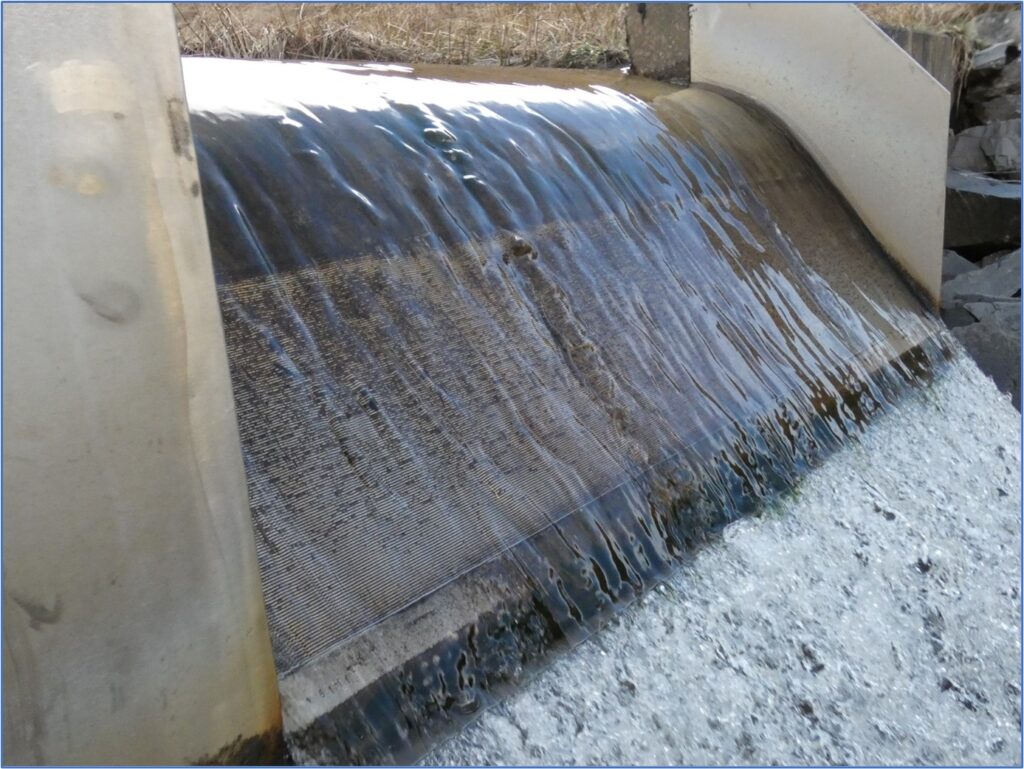Scabcleuch Micro-Hydro Scheme: A Case Study
27 March 2024In 2015 a micro-hydro scheme was installed at Scabcleuch Farm in the Ettrick Valley near Selkirk. Since then, the small 20kW turbine has generated a steady supply of renewable energy for the farm with any surplus being sold to the grid. Incentives for exports to the grid are now very different but the appeal of a farm-scale source of renewable energy sitting almost invisibly in the landscape is in great contrast to the significant impacts other forms of renewable energy can have on our rural landscapes.
This document describes the micro-hydro scheme installed at Scabcleuch in the Ettrick valley in 2015. Apart from the small abstraction site on the Scabcleuch Burn, the scheme sits invisible in the landscape whilst quietly generating renewable energy, supplying the electricity needs of the farm and exporting the surplus to the grid. The growing focus on renewable energy centres around wind and solar power but for those landowners who have the resources, micro-hydro power could provide an alternative which, after the initial installation will sit invisibly in the landscape providing an excellent source of renewable energy for many years.
Scabcleuch Farm
Scabcleuch is a traditional upland hill farm at the top of the Ettrick valley in the Scottish Borders some 30km southwest of the town of Selkirk. The farm has been in the McFadzen family for three generations, and in 1975 the current owners Neil and Irene McFadzen took over the business. The farm steading sits at 250m above sea level and apart from a few in-bye fields on the valley floor, the land is steep and unforgiving. The highest point on the hill ground is Peniestone Knowe at 551m above sea level located approximately 2km northwest of the steading. On the southeastern flank of Penieston Knowe, the Scabcleuch Burn begins its journey down the steep cleuch towards the farm and its confluence with the Ettrick Water. Over this short journey the burn loses over 200m in elevation as it descends towards the valley below.
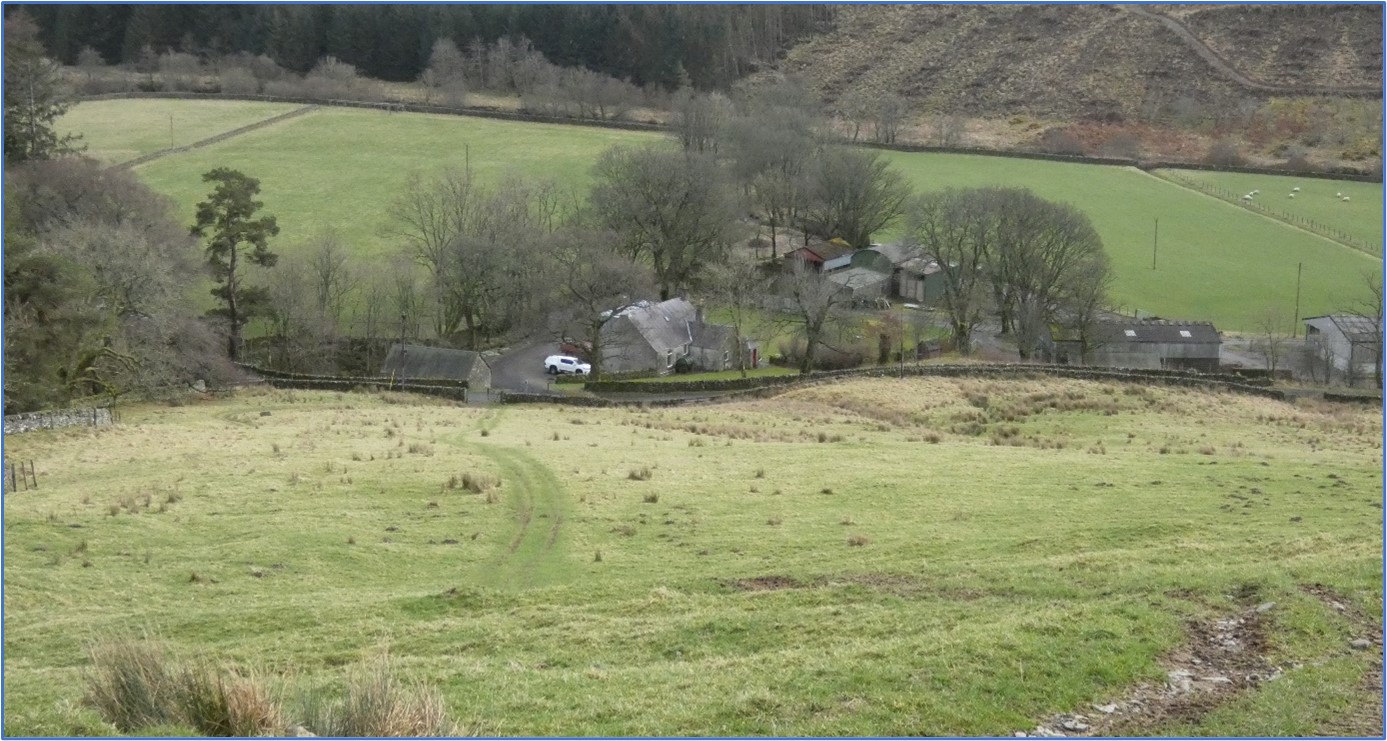
Scabcleuch in the Ettrick Valley.
The supply pipe for the hydro scheme runs through the field in the foreground and the turbine house is to the left of the white pickup.
Background
The idea for the hydro scheme was triggered by two occurrences:
- In 2012 The Scottish Farmer carried an advertisement promoting micro-hydro schemes which caught the McFadzen’s attention.
- Around the same time a local groundworks contractor who was on-site carrying out drainage work mentioned that they had previously done micro-hydro schemes on other farms and the Scabcleuch Burn looked like a suitable location with an excellent drop in elevation which would be ideal for powering a small turbine.
After some time and much consideration, Mr McFadzen approached the renewable energy team at SAC Consulting based near Edinburgh to seek advice and assistance in taking the idea forward.
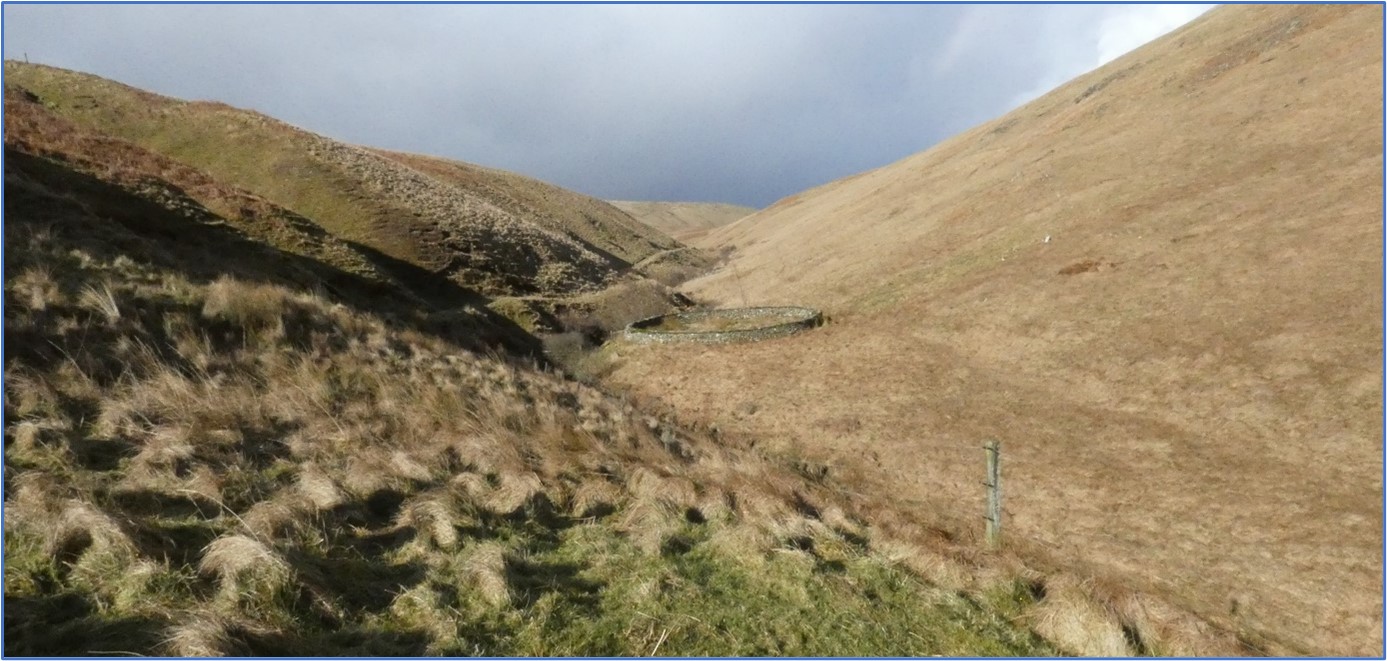
Looking up the Scabcleuch Burn towards Penieston Knowe at 551m above sea level and the source of the burn.
The Process
The renewable energy team at SAC Consulting conducted a comprehensive feasibility study into the proposal and found that it had great potential.
In terms of energy policy and costs, the scheme would fit well into both the Scottish and UK Government’s targets for reducing emissions and increasing renewable energy generation targets. In practical terms the study found a convenient abstraction point on the burn approximately 550m upstream from the farm with a ‘head’ (or drop in height) of over 63m. This rapid drop in height along with water flow data obtained from nearby gauge stations and computer modelling would ensure that the energy provided by the water extracted from the burn would be enough to make the scheme financially viable and provide a sufficient output of renewable energy. Such a system where the water is abstracted without a dam and returned to the same watercourse is called a ‘run-of-river’ scheme which is claimed to produce a more consistent output than either wind or solar power. An added bonus was the presence of an old stone-built shed near to the burn at the farm which would provide an ideal location for the turbine.
The study concluded that the scheme had the potential capacity of 20 kW and was predicted to generate 83 MWh of electricity per annum. This would be enough to provide power for seventeen houses and would displace about forty-five tonnes of CO2 annually. The energy needs of the farm and farmhouse would be fully provided for and the surplus energy would be exported to the grid.
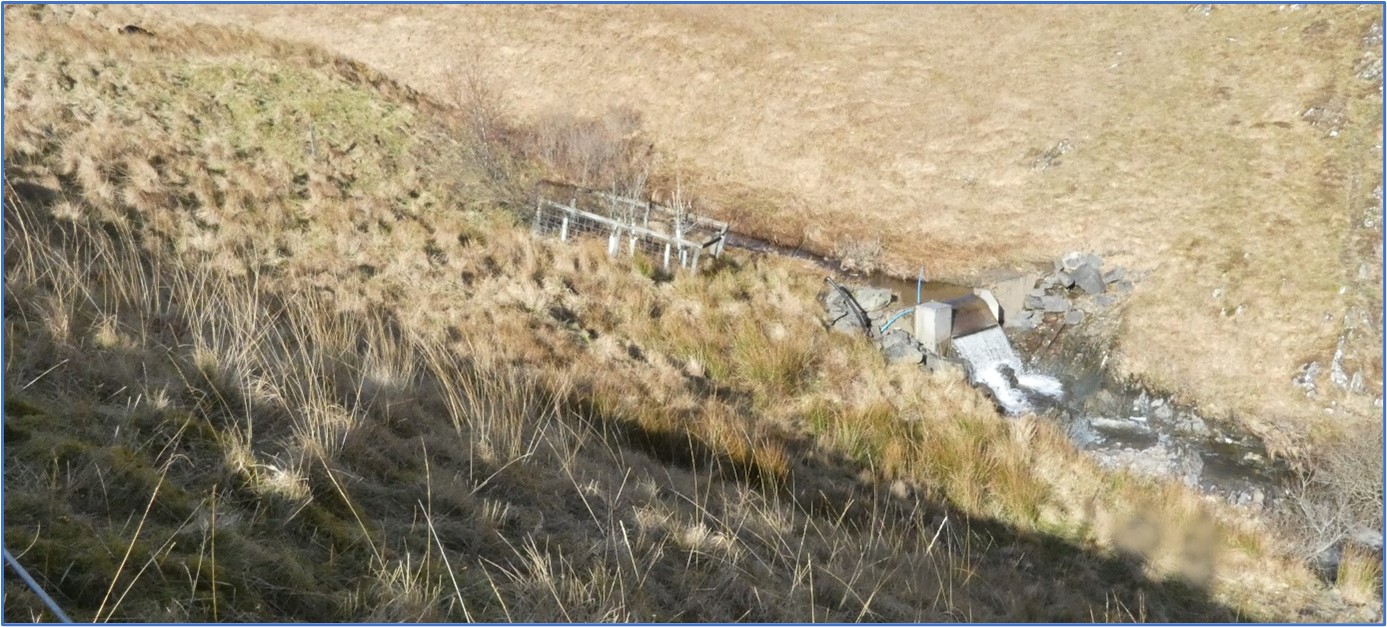
The abstraction point sits unobtrusively in the landscape and the pipeline is not visible at all.
Planning and Consultation
Not surprisingly there were many hoops to go through to progress the proposal further. The site did not fall within any landscape designations such as Sites of Special Scientific Interest (SSSI) and being smaller than 500 kW did not require a full Environmental Impact Assessment (EIA) which made things slightly easier. The full planning and consultation process was handled by SAC Consulting and involved the application for a Controlled Activities Regulations (CAR) licence, a planning application to Scottish Borders Council (SBC), discussions with the Scottish Environmental Protection Agency (SEPA) as well as the preparation of a comprehensive document covering everything from hydrology, the physical design of the scheme, an ecological survey and considerations regarding landscape and visual impacts and safety. In summary the information gathering, surveys, consultations with relevant bodies and scheme design produced the conclusion that:
“The proposed Scabcleuch micro-hydro scheme is clearly in accord with the principals of sustainability and will provide significant environmental, economic and social benefits to the local community.”
The feasibility, planning and consultation process began in early 2013. This was successfully completed by the end of 2014 and the system was installed and commissioned in January 2015.
Design and Construction
The design for the abstraction point was carried out by the renewables team at SAC Consulting, the conveniently located old shed at the steading meant that the turbine house was already there and only had to be adapted to accommodate the supply pipe and the turbine. The local contracting firm (Glendinning Groundworks) who had made the initial suggestion about a hydro scheme back in 2012 were engaged to undertake the construction of the abstraction point and the supply pipeline to the turbine house. Based on the SAC Consulting design brief, Glendinning Groundworks fashioned a custom-made abstraction point at the chosen site on the Scabcleuch Burn. The basis of the structure is a pre-stressed concrete wall panel typically found in agricultural buildings such as grain and livestock sheds. The panel reaches across the width of the burn and is secured into both banks. This ingenious idea does away with the need to construct a barrier on-site and within the burn and simplifies the entire process.
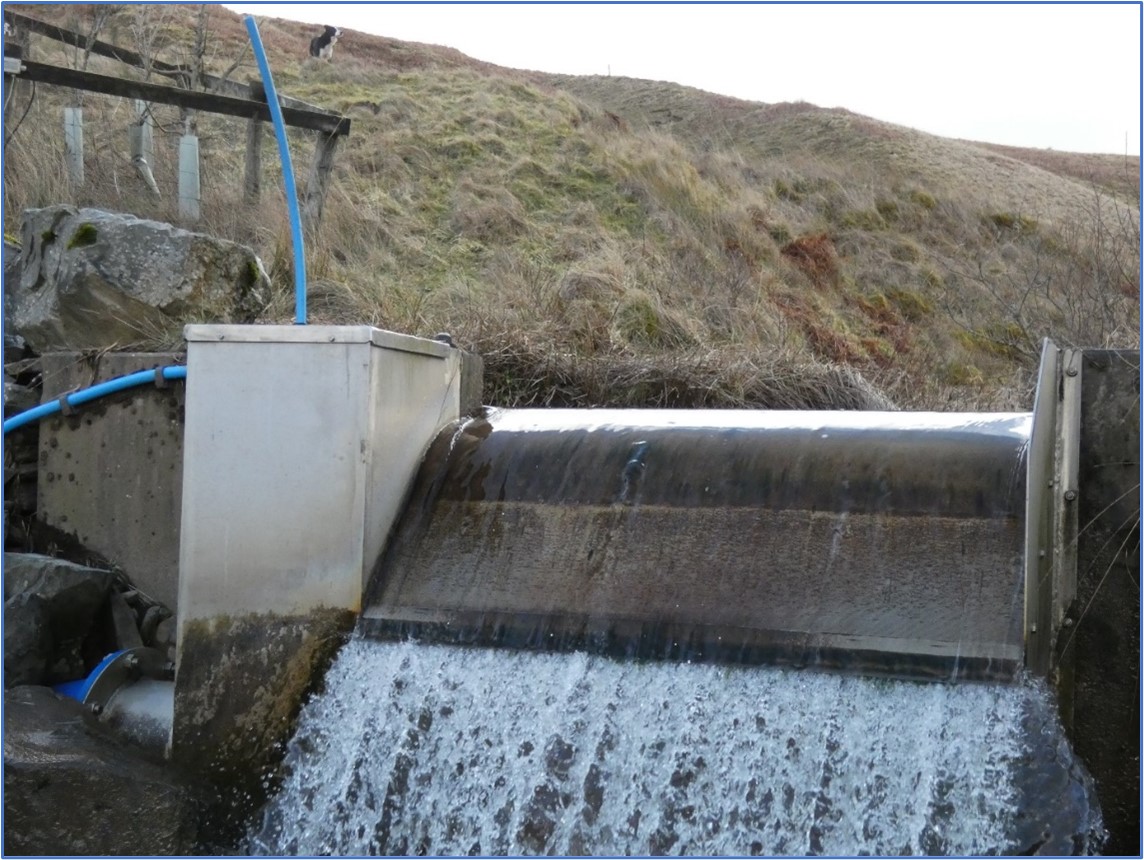
Abstraction point made from concrete shed panel and custom-built collection chamber. The supply pipe can be seen bottom left.
A rebate cut along the top of the panel conducts the water over the collection grid. Glendinning also designed and constructed a galvanised steel collection chamber on the downstream side of the concrete panel as well as the custom-made perforated stainless-steel plate which sits on top and conducts water into the chamber. Enough water enters the chamber through these tiny perforations and is conducted into the supply pipe. The bulk of the water simply flows across the top of the stainless-steel plate and maintains the integrity of the burn.
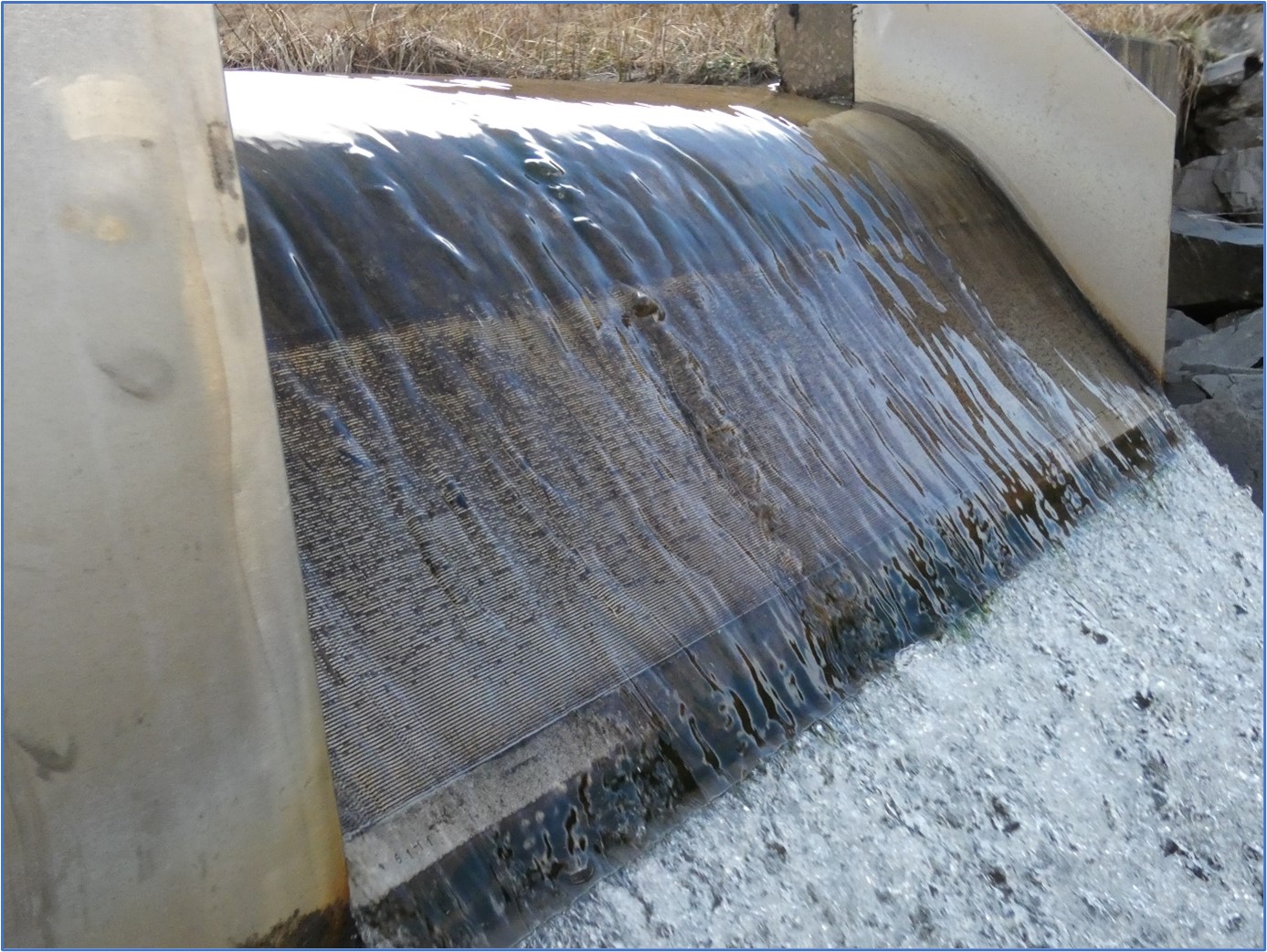
The stainless-streel intake grid. Water passes into the collection chamber through the tiny slots in the steel.
A compensatory/bypass flow gate has also been incorporated into the design so that in times of low water flow the water will continue to flow down the burn instead of going through the pipe. This is important for the ecological health of the burn. The 30cm diameter plastic supply pipe leaves the collection chamber and runs down the hill to the turbine house. The pipe is entrenched at 60-90cm deep and today there is no indication whatsoever that the pipeline exists. This is a huge benefit of the minimal impact on the surroundings that a micro-hydro scheme can have as the Southern Upland Way, a very popular Borders tourist path, runs nearby.
The start of the pipeline runs parallel to the burn in an area of hill excluded from livestock and home to an area of native riparian woodland. It then runs through one of the in-bye fields before running under the road to the turbine house. The only modifications required to the old shed which became the turbine house were taking the supply pipe in through the wall and creating a solid concrete base for the turbine. This concrete base also had to be designed to accommodate the outflow from the turbine which exits to the concrete outfall outside the shed and returns the water into the burn.
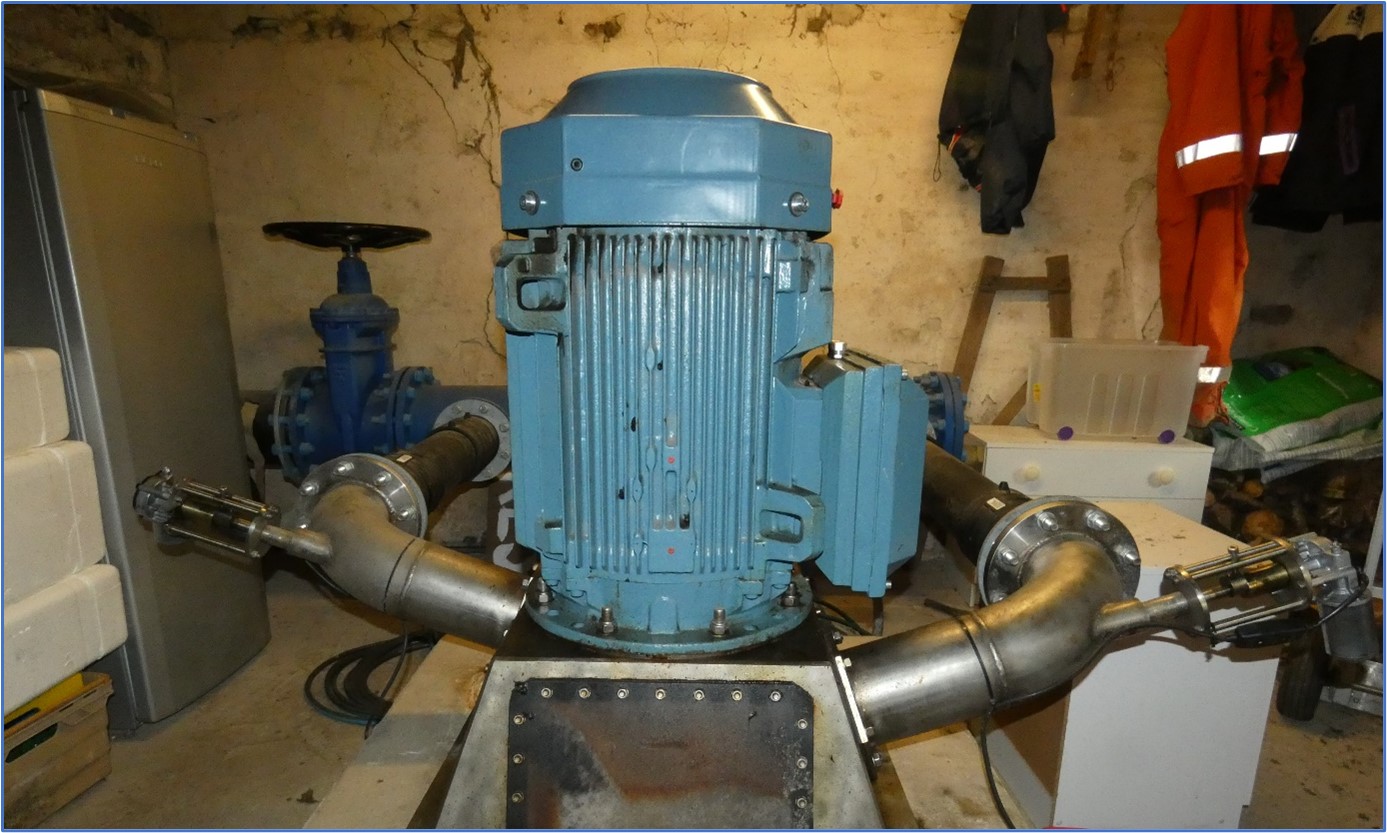
The 20-kWh turbine installed by Derwent Hydropower. Water enters the turbine house via the large blue pipe from the abstraction point. The water is split into two smaller stainless-steel pipes which concentrate the force of the water and direct it onto the turbine blades.
Turbine
The turbine was installed by Derwent Hydroelectric Power Ltd based in Derbyshire who have been involved with micro-hydro power generation since 1988. Based on the data provided by SAC Consulting they supplied and installed a 20kW turbine made by AAR Powerdrives based in the West Midlands. The turbine is designed to be low maintenance. This involves a simple annual service which is carried out by a suitably qualified local electrician who reports back to Derwent Hydro and a monthly greasing of the turbine bearings which is done by Mr McFadzen himself. The turbine ran faultlessly until January 2014 when a minor issue with the electrical control board required the attention of Derwent Hydropower, but the system was back up and running within a few days. The electrical control board is basic and uncomplicated. A meter in the turbine house records the total output of the scheme for feed-in tariff purposes and a separate meter in the farmhouse records how much electricity is used in the house, how much is exported to the grid and how much is imported in times of low flow in the summer and the turbine is off.
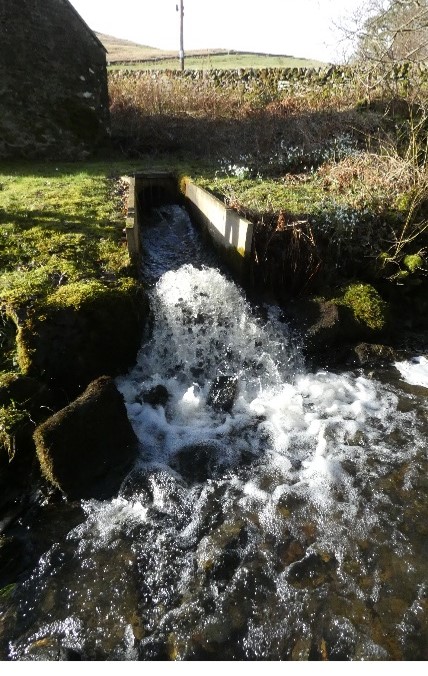
Having given up its energy the water quietly returns to the Scabcleuch Burn
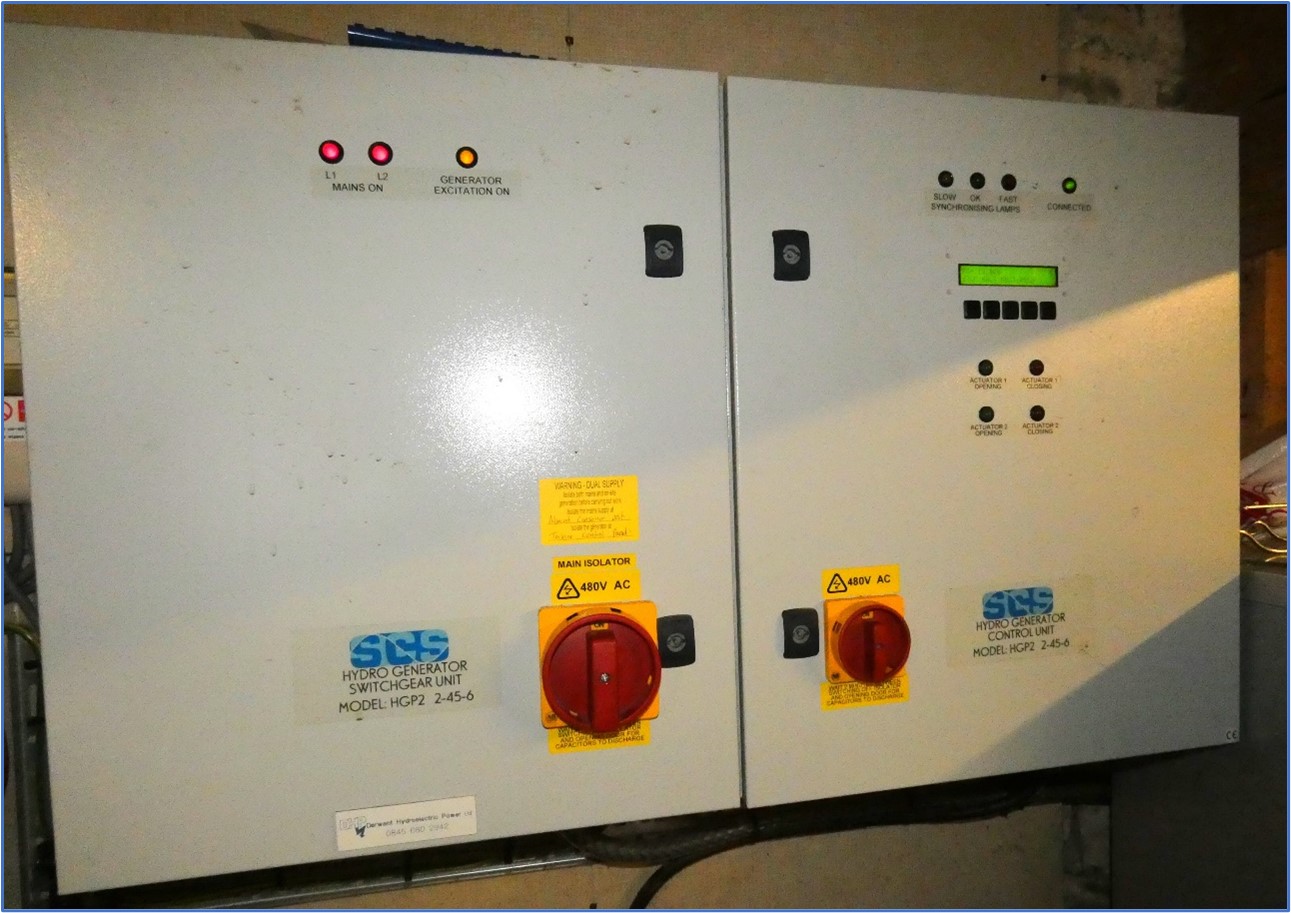
The control panel for the turbine: basic and easily maintained.
Facts and Figures
The first point to stress about the figures involved is that the ‘feed-in tariff’ which the Scabcleuch scheme qualified for was discontinued by the government in 2019. This potentially makes any post-2019 scheme a less financially attractive proposition, however there are still some incentives detailed at the end of this report such as the ‘Smart Export Guarantee’ which are designed to still encourage micro-hydro scheme development.
Something which cannot have a figure attributed to it though, is the personal desire and satisfaction to develop a renewable energy scheme on your property which will reduce your reliance on imported energy and reduce your carbon footprint but which will have an entirely minimal effect on the landscape and will work away invisibly in the background providing your business with a low maintenance source of green energy potentially for decades to come. The longevity of hydro power schemes exceeds other options such as wind and solar.
- The total cost of the project including the consultation process, planning applications, groundworks, materials and turbine came to £148,000.
- The expected payback period was 10 years, but payback was actually achieved in just 6 years!
- Over the course of a year the system generates an average 12 kWh per day.
- Seasonal low water flows generally over three months in summer mean the McFadzen’s do have to buy-in energy at this time, but this is wholly weather-dependant and unpredictable.
- The current cost of bought-in energy under the McFadzen’s “Good Energy” deal is 28.9p/kWh.
- The other nine months of the year have consistently covered the McFadzen’s energy requirements, particularly in winter when energy demand is at its highest.
- The feed-in tariff (which is no longer available) was guaranteed for 20 years.
- The feed-in tariff is payable on 100% of the energy produced.
- The feed-in tariff has varied, at the outset it was 21.09p/kWh currently it sits at 29.49p/kWh.
- So far, approximately 75% of the hydro scheme’s output has been exported to the grid.
- The 75% of exported output receives an export bonus which was 4.7p/kWh at the outset and today stands at 14.12p/kWh.
- The return on capital of the scheme has been approximately 17%.
Summary
- The micro-hydro scheme at Scabcleuch has been a tremendous success for the McFadzens.
- The scheme has exceeded expectations in terms of output, payback time and return on investment.
- The farm’s carbon footprint has been drastically reduced and the reliance on imported energy has been minimised.
- The scheme has been extremely reliable and promises to deliver renewable energy for many decades to come.
- The landscape impact of the scheme is minimal. The Southern Upland Way passes within a few metres of the scheme and with the exception of the abstraction point there is no sign of the scheme whatsoever and the integrity of the landscape is maintained.
Opportunities for Others
The McFadzens were fortunate to have an ideal location for a scheme literally on their doorstep. The topography and the big drop in elevation over a short distance was the ideal scenario for a ‘high-head’ system to be installed. In other locations, ‘low-head’ systems can be used where there is little drop in elevation and the watercourse is of a low-energy status. Archimedes screw type installations are typically used in these cases and interestingly, one such scheme is installed near Selkirk downstream from Scabcleuch which will reuse the water which at one time turned the turbine at Scabcleuch. For the nostalgic this has echoes of a time when water-powered mills lined the course of all the larger Borders rivers using and re-using the same power supply time and again.
Whilst the feed-in tariff is long-gone, there are other incentives currently available to help people considering micro-hydro:
- Business Energy Scotland currently offer loans for renewables and a cashback grant for energy efficiency measures. They can also undertake assessments for interested parties and have advisers who can offer help. https://businessenergyscotland.org/smeloan/
The Smart Export Guarantee from Ofgem ensures that anyone with a micro-hydro scheme will be paid for any surplus which is exported to the grid. https://www.ofgem.gov.uk/environmental-and-social-schemes/smart-export-guarantee-seg
- Certain banks offer cashback schemes and attractive rates for sustainable ‘green’ projects.
As stated earlier in the text, this small inconspicuous hydro scheme produces enough electricity to supply up to seventeen households. In the right location, opportunities will present themselves for small communities to consider their own scheme and thereby spreading the cost more widely.
Along with these incentives, micro-hydro schemes continue to offer an opportunity for individuals or community groups to pursue a path towards greater energy efficiency, reduced reliance on energy imports and a reduction in carbon footprint through the harnessing of a relatively simple and basic technology with exceptional longevity and one which sits comfortably and invisibly in the landscape creating a negligible visual impact so often the bane of other renewable energy projects.
David Brown, SAC Consulting
Acknowledgements:
Thanks to Neil & Irene McFadzen for sharing the background to their renewable energy journey and their permission to write this case study.
Thanks to Robert Glendinning at Glendinning Groundworks for information relating to the construction, fabrication and installation of the micro-hydro scheme.
Thanks also to Iain Boyd at SAC Consulting for information on current incentives for renewable energy.
Related Resources
Sign up to the FAS newsletter
Receive updates on news, events and publications from Scotland’s Farm Advisory Service

